Text
The Gravestone in the Auction House
The first day I walked into my internship for the year, I was greeted with a gravestone leaning against a pillar by the door. According to my boss, he had gotten it in New Hampshire and didn't really know anything about the owner.
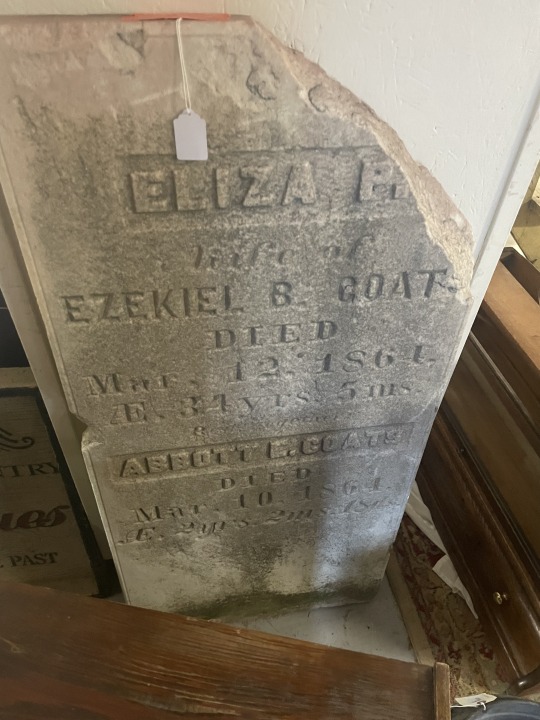
[Grave transcription: Eliza P. / Wife of / Ezekiel B. Coat. / Died / Mar. 12. 1864 / AE. 34 yrs. 5ms. / Rest together / Abbott E. Coats / Died / Mar. 10. 1864 / AE. 3 yrs. 2 ms. 18 ds.]
My curiosity got the best of me and with my boss's permission, I started to hunt down Eliza.
Eliza Pamelia Goodell was born on November 7th, 1829, to Chester and Betsy (Fuller) Goodell in Rowe, Massachusetts. Within a couple years, her family would move to Readsboro, Vermont, to reunite with family in the area. There, 3 siblings would be born. Growing up, Eliza would have been expected to help with child-rearing, despite only being 6 years older than the youngest. Her father is listed as a farmer for most of his life, though an article in the North Adams Transcript hints towards some other activities as well:
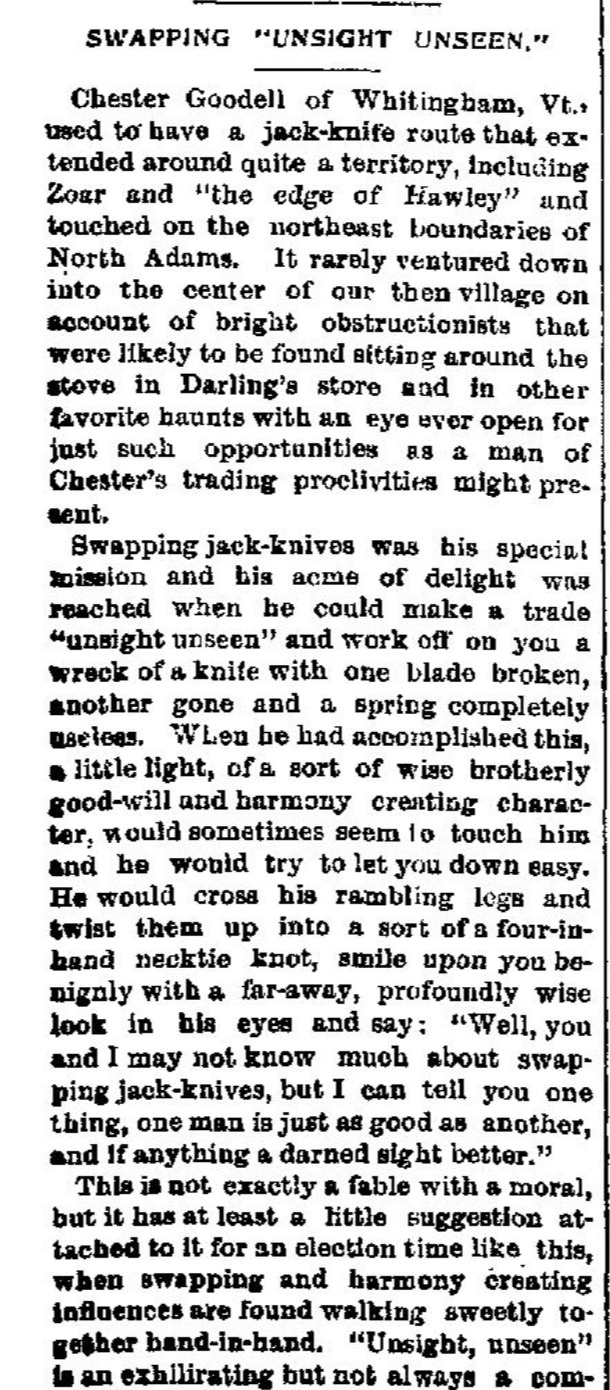
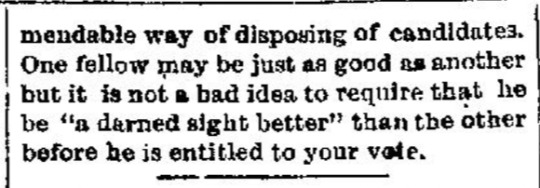
His wife, Betsy, does not appear in any newspaper articles, as far as I can tell.
Despite being a teenager during the Mexican-American War, it would likely be a distant thought, rarely being reported in newspapers and an unlikely topic of conversation.
When she was 21, she would marry Ezekiel Bradford Coates, of Heath, Massachusetts. Ezekiel was the youngest of his siblings, the son of a carpenter. He lost his mother and two of his siblings at a young age, leaving him to be raised by his stepmother and siblings.
A little over a year later, their first son, Albert, would be born. Then came Abbott, Adelbert, and Elnora in Stratton.
In May of 1858, her son Abbott, suddenly grew sick and passed away. His death certificate lists inflammation of the brain as a cause of death, which could be encephalitis, meningitis, or cerebritis in modern terms. He was five. Then, just over a year later, she would lose her mother to cancer. This would have been a devastating time for her, especially with rising tensions throughout the US, it may have felt to her like her world could end at any moment.
In January of 1862, Eliza would have another son, Abbott E, in Townshend. Just a month later, Ezekiel, likely seeing the 75$ bounty for enlistment, would volunteer as a soldier in the Civil War.
That October, Ezekiel would join the rest of his unit as a Corporal in Townshend.
He was part of the 16th Vermont Infantry, Company D, which mainly was on picket duty. Picket duty was keeping an eye on the enemy from their side and keeping their superiors informed. This was extremely important during battles such as the Battle of Gettysburg, which his unit was a part of.
During the Battle of Gettysburg, Ezekiel would have been on the front line, watching others from his unit being hit by shells. A superior officer write on his report:
"In this movement it was under terrific artillery fire, one shell hitting two men and killing them instantly. The regiment was finally halted in support of a battery and just in season to receive and repel a heavy charge of infantry. Darkness soon came on and the battle ceased with the Sixteenth in the front line."
August 10th, 1863, Ezekiel and his unit were mustered out and started making their way home.
The family would enjoy a few blissful months reunited, but in early 1864, a disease began spreading through New England. It would come suddenly, sometimes killing people within two days, and was very infectious.
In early March, Eliza would have seen her two-year-old son, first become feverish, then have a sore throat, and then pass away. During that time, there was not a lot that a doctor could do to help him, and she may have turned to one of the many quack remedies that were advertised at the time. Very soon after, she would have started feeling the symptoms herself, and on March 12th, just one day after her son's passing, Eliza Goodell passed away from Scarlett Fever.
To learn more about the epidemic itself and it's history, there was a journal published at the time discussing it:
She would be buried with her son in Round Hill Cemetery soon after. Her eldest child would have been 11 years old, and without their mother, they were spread to family and friends who could take them in.
In 1867, Ezekiel would remarry and have four more children with his new wife, Charlotte.
Eliza's 3 living children, Albert, Adelbert, and Elnora, continued to live with relatives until adulthood. Albert would end up moving to Rhode Island and becoming a high-level government official in several offices, while Adelbert would run a private coach service in Massachusetts, and Elnora would settle down in Townshend with her husband Charles Boynton.
A possible reason why this gravestone ended up in an auction house was that during the 1890s, the graveyard was renovated, and several gravestones that had fallen into disrepair had to be replaced. It is very possible that Eliza's gravestone was replaced during this time, and the original gravestone was set aside somewhere and forgotten.
4 notes
·
View notes
Text
Who were you, Mary Jane?
For a class assignment, I had to go to the local cemetery and choose a grave to research. I ended up picking a broken, weatherworn grave that just said "Mary Jane". There was clearly more, but the break was part way through the words, and so much of it had worn away that even a gentle pencil rubbing couldn't bring it out. Something about her seemed sad and lonely.
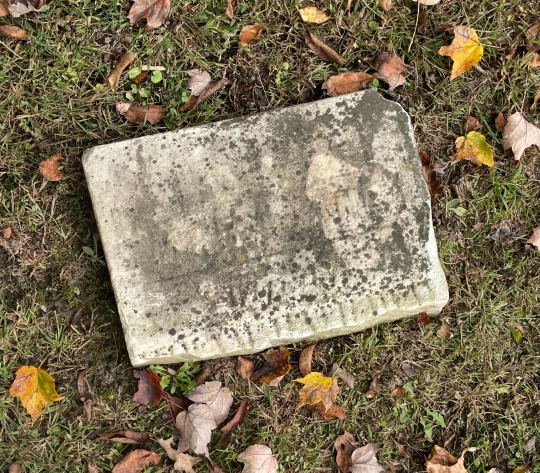
I found her last name, Hathaway, on FindAGrave, where you could see slightly more of the grave and where it was before it was broken. It reads, "Mary Jane, wife of Hiram Hathaway" with the rest sunken into mud.

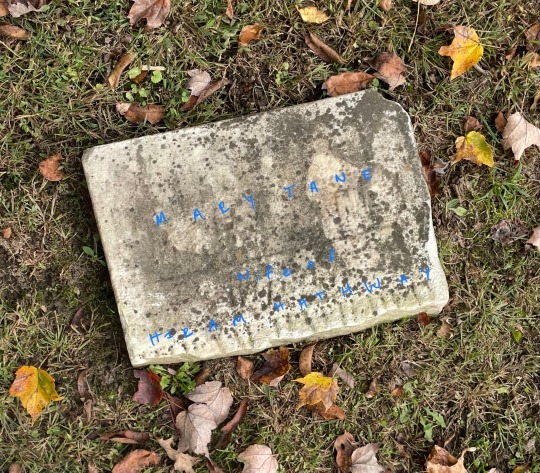
I found her on Ancestry, but her profile was strangely empty. So was her FamilySearch and her Genie. Her husband's was equally empty. Three sources total between them. Eventually, through manually searching through records, I discovered her parents Enoch Aiken and Mary Bailey.
I expected information to start flooding in now, it had been two hours and I finally had enough to do some cursory searching, but the only thing I found was death records, and things on her parents. Eventually, though, things started to reveal themselves.
Mary Jane Aiken was born in 1837 in Cornith, Vermont. Her mother was from Hartford, Connecticut, and her father was from Cornith. Enoch had been a blacksmith all of his life and looks like his father was one too. She had three older brothers, two older sisters, and one younger brother.
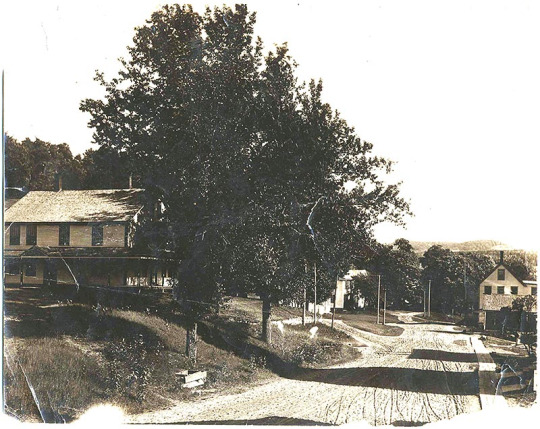
(East Cornith, early 1900s, via Cornith Historical Society)
Mary somehow managed to elude the census all her life, so she disappeared from the historical record for a while. She probably spent the time before her marriage with her family in Corinth.
Her mother passed away from pneumonia in July of 1863. She was 69.
When the Civil War rolled around, (at least) two of her brothers and her father were called to war. The house would have been just her and her sisters. Her father was a blacksmith, part of the First Cavalry Regiment, Company D. He would have seen the Battle of Gettysburg, and came back to tell the tale.
You can read more about his unit here:
One of her brothers though, her little brother William, did not make it back from the war. He was shot and killed in the Battle of the Wilderness, on March 5th, 1864, in Spotsylvania, Virginia. We are lucky enough to actually have a photograph of him publicly available (though the image quality isn't great):
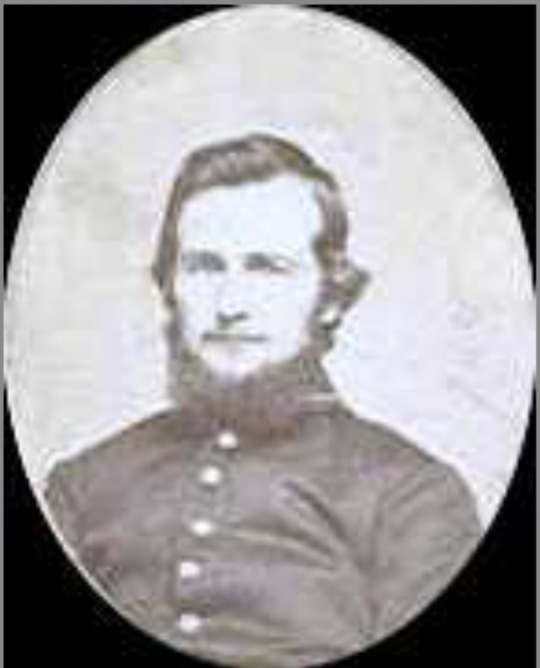
Her father would come back to Cornith, presumably for the funeral, and would pass away the next month, April of 1864 (his records say he died of dropsy).
I can't imagine the amount of loss that Mary and her siblings were feeling, losing both their parents and their little brother in a little over a year.
On April 27th, 1872, Mary appears again, marrying Hiram Hathaway of Bennington, Vermont on April 13th. Depending on when the wedding was, it would have been a rather chilly wedding.
Her husband, Hiram Hathaway, was born in 1837 and had grown up in Bennington. He had several siblings. He had been a farmer most of his life, though he also managed to elude the census a few times so he may have had other jobs.
Hiram had also had a rough 1860s. In 1863, when he was 26, his father took his own life using opium. In 1866, he lost his sister, Mary, though I can't find how she died. In 1868, he lost his mother to old age. After that, the rest of his siblings scattered to the winds. One to Wisconsin, one to Florida.
In June of 1872, her husband would appear in the paper, as putting up no trespassing signs for seemingly no reason. You can read the whole clipping here:
In 1874 and 1875, Mary Jane would write wills that had the executor of her estate as her friend, Abraham Gardner. I couldn't find anything on him, it seems like there were several Abraham Gardners running around Bennington at the time. She notes in her will that she wants all of her money to be put the the benefit of her husband, giving him monthly allowances. She wanted to give everything but the house, furniture, and one set of bedding, to her sister Aphia. We also get to see her signature:

On February 15th, 1875, Mary Jane Hathaway passed away from cancer. In 1876, due to her debts, her entire estate had to be sold off.
As unfortunate as that is, it gives us a very interesting look into her life, as an inventory and appraisal had to be made of all her things.
Among her items, she had:
A stereoscope (though no stereoscope cards were noted)
Many many sewing notions (it seemed to be a hobby of hers)
Numerous photos of family on her walls along with (at least) 3 photo albums.
A room full of books, especially on the history of religion and geography books.
Painting supplies
A box of "trinkets" (probably sentimental items she kept)
Her school book on grammar.
And a much clearer picture of what she was like starts to develop.
She's an avid reader, was very sentimental, and cared quite a bit about her family. She enjoyed sewing and painting, and maybe scrapbooking with the things she collected (though that part isn't confirmed).
In 1880, Hiram remarried to Ellen Thurber, a local Bennington woman. He moves into her parent's house, where he works as a farmer. One family tree says that he died in 1889, but I can't find anything to prove or disprove that. As far as I can tell, Hiram has no death records (at least none digitized). He is also not buried with his parents and first wife. He does not appear to be in the cemetery at all. His story ends with his marriage to Ellen.
Mary's sister, Aphia, died in 1901 due to paralysis in Keene, NH. Her brother, Enoch, would die soon after in a debtor's house.
After finding this all out, I went back to the cemetery looking her Hiram and to visit Mary again. I searched all over that section, but I think if Hiram was buried here, his grave has been eaten by the hill.

Hopefully, Mary's story can be reunited with the rest of her family, and maybe one day some more information will surface about her or Hiram.
I hope so. She deserves to be remembered.
#history#us history#1800s#miss anxiety investigates#miss anxiety’s final report#civil war#genealogy#ancestry#cemetery#vermont#Mary Jane Hathaway#mystery grave
4 notes
·
View notes
Text

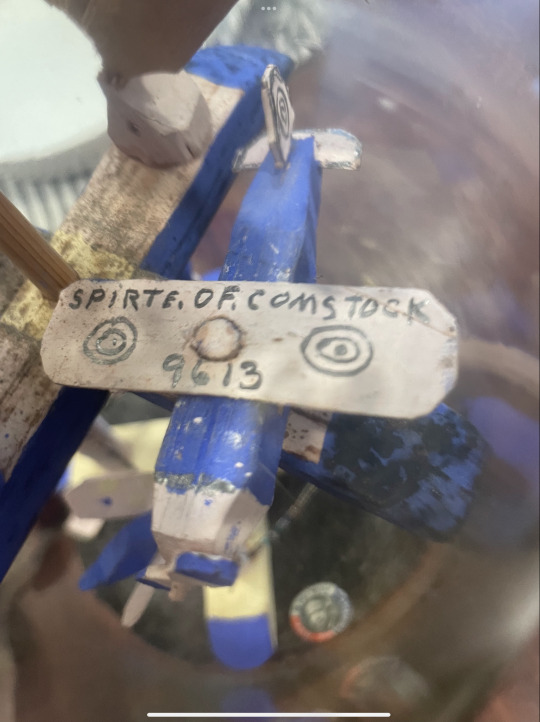
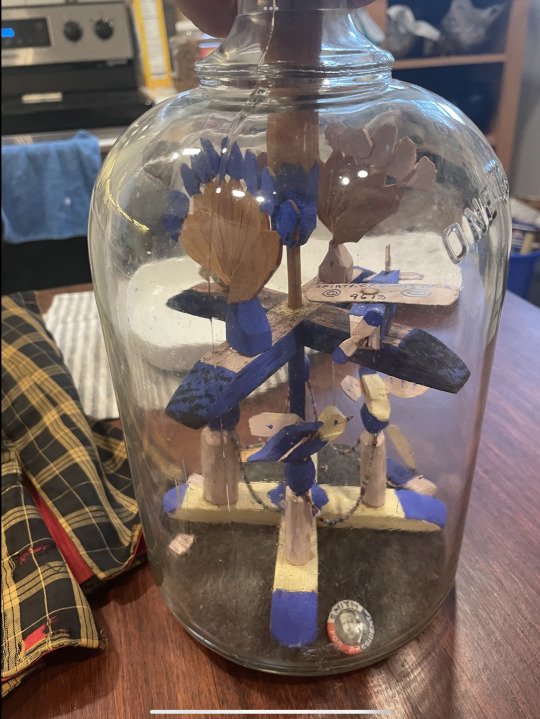
This was made by Tony Deliss, born 1890, in New York. Deliss likely grew up in Wall Street/Battery Park area, going to school and leaving after learning to read and write. He then took up driving and loading trucks, where he likely met the gang The Hundson Dusters (primarily Italian). They were known as one of the largest gangs at the time, mainly committing small crimes such as stealing from loading docks and petty theft. Through them, he became very close friends with Robert “Rabbit” Crosby, who would be entangled in the events leading to his jailing. In July of 1914, Tony Deliss would end up committing 2nd degree murder on a John Hurst. The testimony of these events are complicated and rather confusing, but as far as I can tell, this is what happened:
Tony Deliss and Rabbit Crosby went to a party that was happening on Greenwich Street, which was part of the First Ward Gang’s territory (as far as I can tell, this is not thier actual name, but the courts consistedly called them this). Preparing for trouble, Deliss told Crosby to bring a gun. John Hurst, the victim and member of the First Ward Gang, arrived first with a large group of friends. Deliss and Crosby arrived a short time later with their friend Bettran (and his wife). During the dance, Hurst would dance with Bettran’s wife, which enraged Bettran. He then went to Crosby, who said to talk to Deliss, who hatched a plan to get revenge. Deliss told Crosby that he would lure Hurst outside and when Deliss pushed him, that would be the signal to “let him have it.” Crosby asked why he had to be the one to do it, to which he responded Crosby was the one with a knife and a gun, and he would be fine.
Later that night, Hurst would end up going outside, with Deliss and Crosby following him. Deliss pushed Hurst, and Crosby shot him 3 times in the back. Only one of the bullets ended up being fatal, and not immediately. Several police (while doing rounds) heard the shots, along with several party goers and came to see what happened. Crosby and Deliss would running away, distracting concerned police with a stranger running. Hurst got up, and calmly walk through the dance hall and up the stairs to a spare bedroom, and lie down on the bed, still bleeding profusely. Crosby was caught by an officer heading to the scene, Deliss was caught later. Hurst would be taken to the hospital where one of the bullets was removed, and the other was found to be in his intestines. He would die of septicemia (infection) 3 days later. Deliss would hide the pistol in Crosby’s house, to be disposed of later. At the police station, Crosby was threatening any witnesses that were brought into the station, which was overheard by the police.
If you want to read the whole court documents, they are available here:
Crosby would plead guilty to second degree murder, and Deliss would be convicted in January of the next year. Deliss was sentenced to to 20 years to life in Sing Sing. At the sentencing, (according to a gossip newspaper) Deliss and his wife were calm, while his sister was wailing curses towards Crosby.

A couple weeks later, he would be admitted to Sing Sing, and later Auburn and Great Meadow Prisons. In 1924, an article was written about him, saying that he was not locked in a cell each night, but rather slept in the stables with the horses, spending all his time taking care of them. He was the most trusted inmate in the prison, as he could escape at any time and seems to have no interest in it. It was likely around this time he made the Comstock airplane piece.

He would be released in April of 1930, serving 15 years of his sentence. 3 years later, he would appear in the newspaper again, as part of a bar brawl, but it was determined in court that he was not to blame and just got swept up in another person’s fight.
He would not appear often in the newspaper after that, eventually marrying John Hurst’s widow, Mary, who would occasionally get him into trouble with gangs. He would die in 1947, at age 57. The records state he died of heart disease, and was buried in Calvary Cemetery. He did not have an obituary.
#history#early 20th century#the Hudson dusters#Tony Deliss#miss anxiety’s final report#true crime#new york gangs#researchreports#1920s#1910s#us history
2 notes
·
View notes